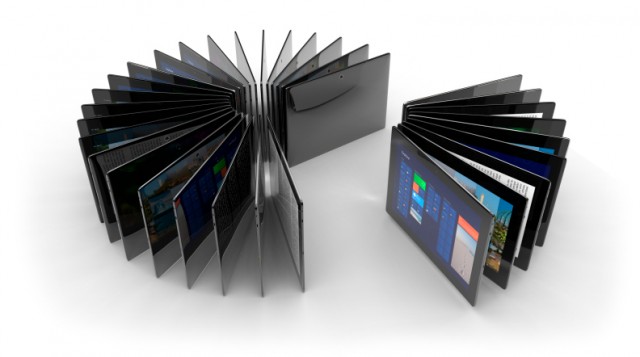
Just a couple of short years ago, the presence of tablets in schools was an exceptional phenomenon. This year, as students across the country go back to school, the presence of tablets is far more common in classrooms. Though it's definitely not the norm yet, many more schools and districts are investing in the devices for a variety of reasons.
A recent study conducted by Harris Interactive for publisher Pearson showed that, while 44 percent of kids are using some kind of tablet for learning, 92 percent of kids surveyed believe that using a tablet in school will change how they learn in the future. And 90 percent of students said using a tablet makes learning more fun.
Though the iPad gets most of the limelight, other tablet makers like Intel, Samsung, Google, and Amplify are getting into the game, providing a variety of education programming, apps, and curriculum. From plug-in paint tools to magnifying glasses, tablet makers are competing for a share of the education market by creating new ways to use tablets in class.
Though this is not an exhaustive list of every type of tablet used in schools, here are the top-rated devices for education and a look what's distinct about each one.
-
VINCI Android Tablet for young children, ages 1.5-9 years. ($110-$184.99)
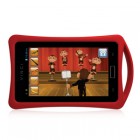
This affordable tablet is aimed at the youngest students, and has won an International CES Innovations Design and Engineering Award for its unique VINCI curriculum. VINCI has broken down learning apps into two groups -- Home and School -- and categorized both by age and subject. The for-school portion’s curriculum categories are Early Math, Language Arts, Early Science, Thematic Units, and Learning Centers, but using the WiFi on the tablet allows access to download more apps from Google Play. Tablets come with tempered glass screens and sturdy plastic cases, and are available in three options: the Tab II 7”, the Tab III M 5”, which supports child voice recognition and can be networked together for children to play in groups, and the Tab MV 5”, which is a WiFi tablet and smartphone combination. The 7" version is the School Edition. The downside is that most apps aren’t appropriate for older children, and some wonder if it’s just a toy disguised as a “learning device.”
-
Amplify Tablet for K-12 Education. ($299-$349 for tablets, with 2-year curriculum subscription fees ranging from $99-$179)
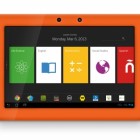 News Corp’s entrance into the tablets-for-education market promises technology that connects students and teachers while being Common Core aligned. The 10” tablet, featuring the Android 4.2 Jelly Bean operating system, comes preloaded with Amplify’s exclusive education platform as well as lots of Google products, including Goolge Play, Google Hangout, Google Messenger and Google Talkback. Amplify also offers professional development both at the district level and to teachers to learn how to integrate the tablets - and curriculum - into classrooms. One of Amplify’s strengths seems to be how tailored it is to educators: “This actually offers features to teachers aimed at delivering instant feedback and differentiated instruction,” writes Terrence O’Brien at Endgadget. “Everything from taking attendance and blocking distracting apps, to polling students comprehension and pushing supplemental materials to those that need it can be managed from the educator's unit. There's also the ability to build custom lesson plans called Playlists, that can incorporate material from locally stored textbooks, pre-loaded Khan Academy videos and the internet.”
News Corp’s entrance into the tablets-for-education market promises technology that connects students and teachers while being Common Core aligned. The 10” tablet, featuring the Android 4.2 Jelly Bean operating system, comes preloaded with Amplify’s exclusive education platform as well as lots of Google products, including Goolge Play, Google Hangout, Google Messenger and Google Talkback. Amplify also offers professional development both at the district level and to teachers to learn how to integrate the tablets - and curriculum - into classrooms. One of Amplify’s strengths seems to be how tailored it is to educators: “This actually offers features to teachers aimed at delivering instant feedback and differentiated instruction,” writes Terrence O’Brien at Endgadget. “Everything from taking attendance and blocking distracting apps, to polling students comprehension and pushing supplemental materials to those that need it can be managed from the educator's unit. There's also the ability to build custom lesson plans called Playlists, that can incorporate material from locally stored textbooks, pre-loaded Khan Academy videos and the internet.”
-
XO Tablet by One Laptop Per Child ($149.00)
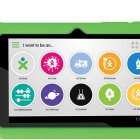 Designed by Yves Behar’s Fuseproject, this affordable 7” tablet meant to be used around the globe is offered by the nonprofit One Laptop per Child. The WiFi enabled tablet features a touch-screen made of multi-touch, flexible plastic, “so many hands can play and learn together.” The tablet can be used as a horizontal book, a portrait-style book, can turn into a full keyboard and features both a front and back-facing camera. Featuring special Android-based XO software and available in English and Spanish and soon may other languages, the XO Learning System is built around 12 “dreams,” or professions children may be interested in.
Designed by Yves Behar’s Fuseproject, this affordable 7” tablet meant to be used around the globe is offered by the nonprofit One Laptop per Child. The WiFi enabled tablet features a touch-screen made of multi-touch, flexible plastic, “so many hands can play and learn together.” The tablet can be used as a horizontal book, a portrait-style book, can turn into a full keyboard and features both a front and back-facing camera. Featuring special Android-based XO software and available in English and Spanish and soon may other languages, the XO Learning System is built around 12 “dreams,” or professions children may be interested in.
-
Samsung Galaxy Tab + Samsung School ($199.99 - $499.99)
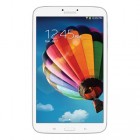 Samsung’s tablet comes in four sizes - from 7” to 10.1” - and Samsung’s brand new Galaxy 3 7.0 is an entry-level tablet that promises a lower price point ($199.99), and has just announced plans of creating a tablet just for kids. Samsung is playing in the major-brand tablet market, with large processors and featuring front and back-facing cameras enabled for photo and video. While there have been reports that Samsung will be creating a Learning Hub similar to iTunes U in the near future, for now Samsung offers Samsung School, which seeks to be a learning management system for educators. Features include an interactive whiteboard that can simultaneously appear on student tablet screens, conduct Q&As and polls, and organize ebooks and apps, too.
Samsung’s tablet comes in four sizes - from 7” to 10.1” - and Samsung’s brand new Galaxy 3 7.0 is an entry-level tablet that promises a lower price point ($199.99), and has just announced plans of creating a tablet just for kids. Samsung is playing in the major-brand tablet market, with large processors and featuring front and back-facing cameras enabled for photo and video. While there have been reports that Samsung will be creating a Learning Hub similar to iTunes U in the near future, for now Samsung offers Samsung School, which seeks to be a learning management system for educators. Features include an interactive whiteboard that can simultaneously appear on student tablet screens, conduct Q&As and polls, and organize ebooks and apps, too.
-
Intel Education 10” Tablet (price not yet available)
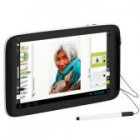 Intel just released its plans to add a tablet for education to its line of products, featuring a powerful processor and tools promised to be especially useful in education -- including an e-Reader, painting tools and accessories, and a suite of tools made for science exploration, like an attachable magnifying glass and thermal probe. The tablet, which runs on Android operating system code-named Ice Cream Sandwich, boasts an extra-long battery life and comes preloaded with Intel’s Education Software package, which includes special math and science apps like the Education Lab Camera, SPARKvue and Kno Textbooks.
Intel just released its plans to add a tablet for education to its line of products, featuring a powerful processor and tools promised to be especially useful in education -- including an e-Reader, painting tools and accessories, and a suite of tools made for science exploration, like an attachable magnifying glass and thermal probe. The tablet, which runs on Android operating system code-named Ice Cream Sandwich, boasts an extra-long battery life and comes preloaded with Intel’s Education Software package, which includes special math and science apps like the Education Lab Camera, SPARKvue and Kno Textbooks.
-
iPad Tablet and iPad Mini ($329.99 - $729.99)
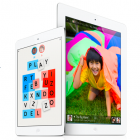 With reportedly over 10 million tablets already in schools, iPad continues to lead the way in using handheld technology to further education. Both the 9.7” tablet and the 7.9” Mini feature front and back-facing cameras, access to thousands of books and textbooks through iBooks, the App Store and iTunes U. While Apple remains proprietary in integrating all its products to work together, it has also has smartly eschewed fancy add-ons and accessories, seeming to focus on providing the best learning games, apps and content to satisfy schools’ very real needs to integrate technology into classrooms.
With reportedly over 10 million tablets already in schools, iPad continues to lead the way in using handheld technology to further education. Both the 9.7” tablet and the 7.9” Mini feature front and back-facing cameras, access to thousands of books and textbooks through iBooks, the App Store and iTunes U. While Apple remains proprietary in integrating all its products to work together, it has also has smartly eschewed fancy add-ons and accessories, seeming to focus on providing the best learning games, apps and content to satisfy schools’ very real needs to integrate technology into classrooms.
-
Dell Latitude 10” Tablet (call for pricing)
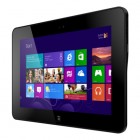
Dell’s tablet computer, which runs on Windows 8 and contains Intel Inside processors, promises much of the same technology as other large-brand tablets - WiFi, cameras, touch-screen technology as well as Microsoft Office Home and Student. While it appears that Dell offers no education-specific software or features, much of the technology available, like Google Play for Education, will be easy to access.
-
Google Nexus Tablet 7” and 10” ($229.00 - 499.00)
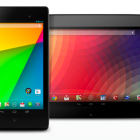
While some consider the Google Chromebook laptop as lean and efficient as a tablet, Google is getting into the table market with its Nexus series. And, with the announcement of Google Play for Education coming sometime this fall, Google’s Nexus tablet will surely be a major competitor for the Apple/iTunes education market. While Nexus offers nearly the same tablet experience as other large brand tablets like iPad and Samsung, the Nexus is preloaded with all the Google products - Google Messenger, Hangout, Play and Talkback, and more - and makes integrating what students are already doing on Google seamless and easy.

